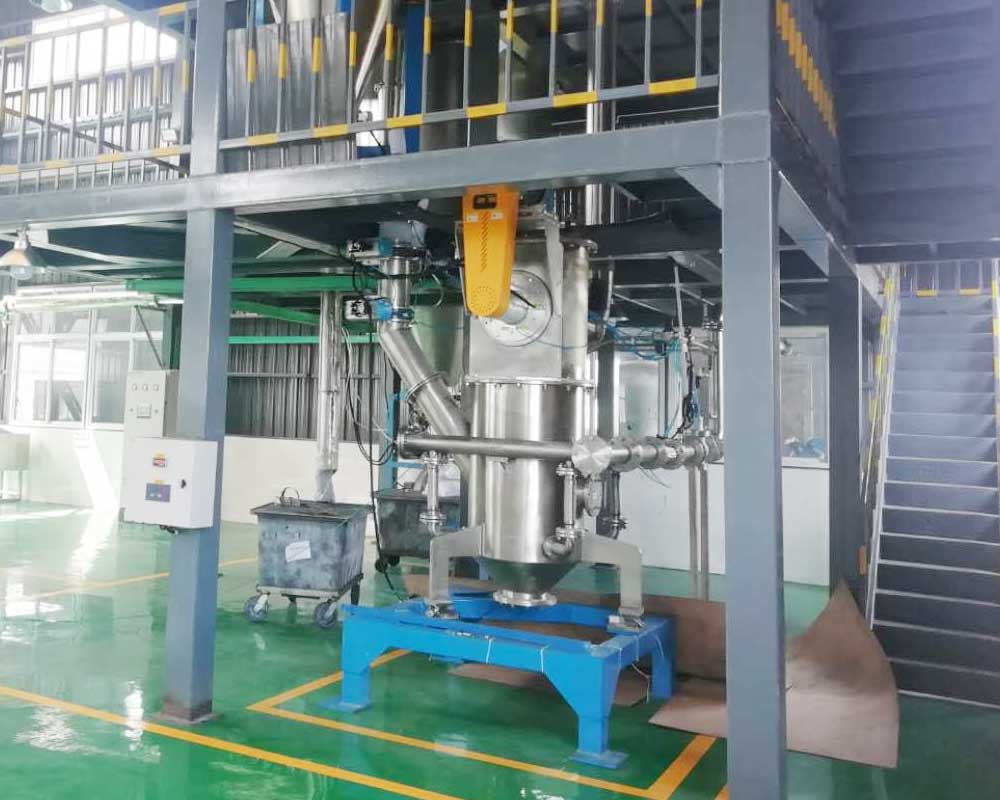With the rapid development of the global economy, the powder industry is booming, and powder equipment, especially ultra-fine grinding equipment, plays a key role in it. The jet mill is one of the most common ultra-fine grinding equipment.
Jet mill, also known as jet mill, jet mill or fluid energy mill. The dry and oil-free compressed air or superheated steam is accelerated into supersonic airflow through the Laval nozzle. The ground material reaches the classification area with the air flow, the material that meets the required fineness is finally collected by the collector, and the material that does not meet the requirement is returned to the grinding chamber to continue grinding until it reaches the required fineness and is collected.
Features of jet mill
Jet mill is widely used for ultra-fine grinding of non-metallic minerals, chemical raw materials, health food, rare earth, etc. below medium hardness such as talc, marble, kaolin, etc.; it can also be used to grind low melting point and heat sensitive materials.
- Advantages
The products processed by the jet mill have the characteristics of high purity, high activity, good dispersibility, and smooth particle surface. In addition, the production method is dry production, which does not require dehydration and drying of materials, so it is very popular in the grinding industry.
- Disadvantages
The equipment manufacturing cost is high, the one-time investment is large, the energy consumption is high, and the powder processing cost is high; it is difficult to produce sub-micron products; the single-machine processing capacity of the jet mill is small, and it cannot meet the needs of large-scale production. In addition, the processing accuracy of the equipment The wear problem with the material is still a big problem.
Classification of jet mills
According to the way the particles are ground, it can be divided into single air flow type and multi-air flow type; according to the type of fluid medium, it can be divided into high-speed air flow type and hot steam flow type; It is divided into flat jet mill, circulating jet mill, target jet mill, counteract jet mill, and Fluidized Bed Jet Mill. Among them, the Fluidized Bed Jet Mill has obvious advantages and represents the mainstream direction of the development of jet mill equipment.
- Fluidized bed jet mill
It is mainly composed of grinding nozzle, grading rotor, grading shaft air seal device, discharge pipe air seal device, discharge pipe, grading motor, feeding device and other parts. Fluidized Bed Jet Mill has many advantages, such as high crushing efficiency, low energy consumption, light wear and less pollution, small equipment size, small footprint, high degree of automation, low noise, large production capacity, and suitable for large-scale production. The current ultrafine grinding equipment is widely used.
- Horizontal disc jet mill
Horizontal disc jet mill, also known as flat jet mill, is the earliest jet mill in industry. It is mainly composed of a feeding system, an air intake system, a grinding-classification and a discharging system. This jet mill is mainly impact grinding, grinding and shredding at the same time, and has the function of self-classification. The structure is simple, the operation is simple, and it has the function of automatic classification. If the hardness of the material to be ground is high, the material will be damaged due to the high-speed movement of the airflow and the inner wall of the grinding chamber, which will cause severe friction, which will also cause a certain degree of pollution to the product.
- Circulating tubular jet mill
The main grinding parts of the circulating tubular jet mill are the feeding ejector and the grinding chamber. The main machine is simple in structure and easy to operate; it has automatic grading function while grinding; the main machine is small in size and large in production capacity; the product fineness is good, up to 3~0.2μm. The impact and wear of the air flow and the material on the inner wall of the tube are too serious, so it is not suitable for the refinement of materials with higher hardness. The grinding efficiency is the lowest among all types of jet mills, and the energy consumption is the largest.
- Jet mill
Jet jet mill, also known as reverse jet mill, is a device in which materials collide with themselves in supersonic airflow to achieve ultra-fine grinding. The production capacity is large, which avoids the wear of the particles on the pipe wall and the pollution of the powder particles by the pipe wall material, and can produce ultra-fine powder with high material hardness. The structure is complex, the volume is huge, and the energy consumption is high, and the gas-solid mixed flow still has certain wear on the grinding chamber and pipes.
- Target jet mill
Target jet mill, also known as single jet jet mill, is a device that makes materials impact fixed or movable target plates of various shapes at high speed for grinding. Simple and easy to operate; large grinding force and high grinding efficiency, especially for the grinding of low melting point, heat-sensitive materials and high molecular polymers. The product is thick and the energy consumption is large; the high-speed moving material particles and air flow have a strong erosion effect on the target plate, and the target plate is seriously worn, which will cause product pollution.
All in all, there are many types of ultra-fine jet milling equipment, and there are obvious differences in the structure of each type of equipment, with corresponding advantages and disadvantages. In the future, the development trend of ultra-fine jet mill equipment will focus on: increasing the output of a single machine and reducing the energy consumption per unit product; improving the product fineness and strengthening the crushing limit of the equipment; online control of product fineness and particle size distribution.
